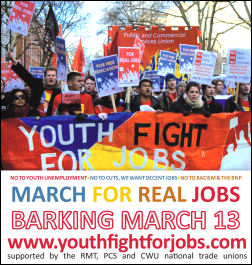The latest Office for National Statistics (ONS) figures showed a fall in unemployment from September to November 2009 of 7,000, to 2.46 million. For young people, the drop was more dramatic, down 16,000. The number claiming unemployment benefits also decreased, by 15,200, to 1.61 million.
But this does not tell the whole story, as the number of people in full-time employment fell by 113,000 while part-timers increased by 99,000 to reach a record high of 7.71 million.

Youth Fight for Jobs campaigns against unemployment
“There were 1.03 million employees and self-employed people working part-time because they could not find a full-time job. This is the highest figure since records for this series began,” said the report. Also, “The number of inactive people of working age increased by 79,000 over the quarter to reach a record high of 8.05 million”.
Some people choose not to work, but others give up the search for work because of the futility. For example, only one in four 18-24 year olds who stop claiming the dole, stop because they have got a job. But giving up the search for work decreases the unemployment figures, which the government can then selectively trumpet in the run-up to the general election.
Also, the statistics are based on a random sample rather than every individual. Therefore, there is room for error; the ONS estimates that its figure on the number of unemployed people could be as much as 82,000 out.
So a 7,000 drop for one three-month period does not signify a decisive change. And while there are less than half a million job vacancies for two and a half million jobseekers (plus one million part time workers), that will not change.
Ben Robinson







